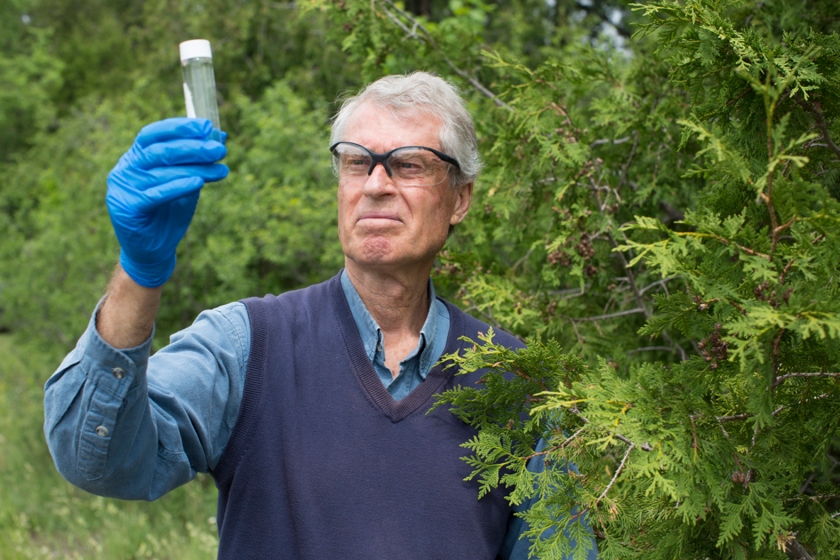
Canadian groundwater scientist John Cherry has long been trying to answer questions that everyone takes for granted: how he can get to the water under the ground we stand on? And more importantly, what flows in it?
Groundwater, which is found in the cracks of sand particles and stone fragments underground, makes up 96 percent of the world’s usable freshwater supply.
In China, 60 percent of the population living in major cities use water extracted from wells. In Hong Kong, although groundwater is not the main source of water supply, it is going into the harbor, which brings about many ecological implications.
So, what flows in the water that affects us so dearly? Fertilizers, improperly disposed chemicals and sewage are correct educated guesses.
Surprisingly, groundwater scientists have also detected in other parts of the world traces of artificial sweeteners found in soft drinks, caffeine, cosmetics, and the pain and fever drug Tylenol.
“Groundwater is a repository for our way of modern living,” Cherry said.
To study the makeup of groundwater and its flow, scientists will drill boreholes as deep as 30 meters below ground. The depth is where farmers usually have wells.
“This is what I have been doing for 50 years,” said Cherry, 75. “One of my main thrusts has been, and continues to be, figuring out a better way to put things in these drill holes so we learn more.”
His vision and dedication eventually led him down the path of winning this year’s Lee Kuan Yew Water Prize, which honors outstanding individuals or organizations that have contributed to solving global water challenges through innovative technologies, policies or programs.
Among the significant findings derived from Cherry’s works, one proves that natural chemical deposits and contaminants found in an aquitard – a clay-rich zone 20 to 25 meters deep underground – can spread by diffusion to another zone called an aquifer that is directly underneath it.
Before the discovery, groundwater scientists believed that aquitards were impervious. So in theory, groundwater that runs through an aquifer – a layer of rock or sand that can absorb and hold water – is unspoiled. The theory turned out to be false.
The new findings changed the way groundwater is studied.
And two separate researches that Cherry carried out in 2010 and 2013, in collaboration with scientists at the University of Hong Kong and Sun Yat Sen University in Guangzhou, have changed perceptions about water management in the Pearl River Delta.
The researches debunked a long- held assumption that attributed the use of fertilizers as the cause of the abnormally high concentration of ammonium found in the aquifer in the area.
The presence of ammonium in groundwater can turn nearby rivers or lakes eutrophic.
“The ammonium comes from the mud that was laid down by the river thousands of years ago. The mud accumulated nitrogen which gradually gets converted into ammonium, and it seeps down into the aquifer,” Cherry explained.
“That means the problem is not a human-induced problem. From the point of view of management, government just needs to realize that that source of ammonium going into the rivers and estuaries will go on forever. You don’t want to dig deep ditches and make it worse.”
In terms of teaching achievement, the 1979 textbook Groundwater, which Cherry co-wrote with Allan Freeze, a professor at the University of British Columbia in Vancouver, is widely considered “the bible” for students reading hydrogeology.
Today, Cherry, who is the distinguished professor emeritus in hydrogeology at the University of Waterloo in Ontario, is still an active field researcher. He and his team of students travel all over the world to study groundwater.
A continuing project is to further the investigation into aquitards, which is a field still in its infancy.
“There are dozens of cities around the world along the coastline that are sitting on top of the soft, mud-type of material. The Pearl River Delta is typical, and it just so happened the chemicals found are ammonium and arsenic,” Cherry said.
“In other areas, the chemicals will be different. And as in many coastal cities sitting on a delta, it’s the aquifer where people get water. Our message is if you really want to understand the chemistry of the water in an aquifer, you have to understand the water in the aquitard, which can be easily done.”
Another project that Cherry is working on is a “living textbook” that he wants to put on the internet, and keep revising its content, for free. It will be published in April on hydrogeologistswithoutborders.org.
The GW2.0 textbook will contain updated chapters from his 1979 publication, as well as new texts and videos co-authored by two dozen other groundwater experts. The aim is for the book to be a teaching tool to help professors and undergraduate students.
“We hope that this field – groundwater science and engineering – will have a common denominator of advanced information. Right now, there is a lot of confusions out there,” Cherry said. “We want a book that students from wherever can feel a relationship to it. So, there will be professors from China involved, and we will have section on every country.”
The article first appeared in the Standard on August 23, 2016.